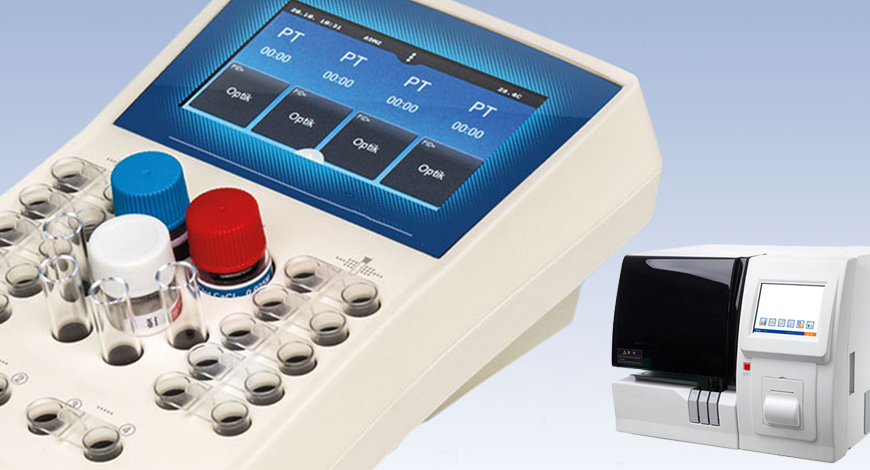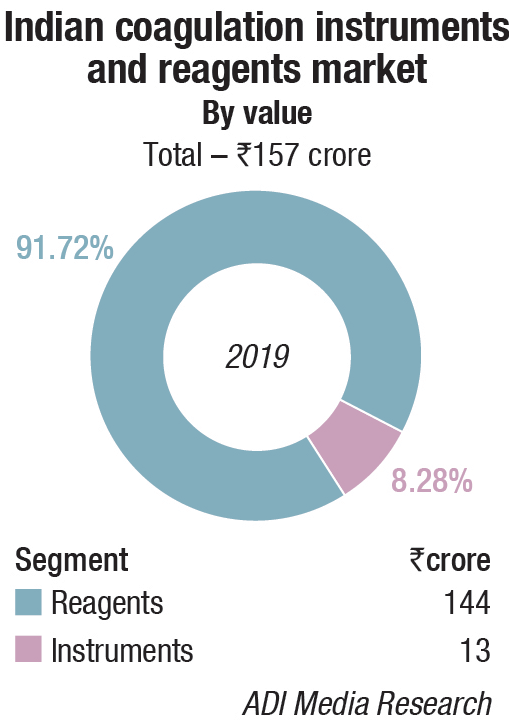Coagulation Instruments and Reagents
COVID-19 and the D-dimer

Despite the fact that D-dimer is a nonspecific acute phase reactant and may be elevated by other causes and inflammation, it has been shown that a consecutive increase in D-dimer may indicate the presence of thrombosis and PE in critically ill COVID-19 patients.
 As India gears up to vaccinate its 1.3 billion citizens, it is important to understand the pathophysiology and clinical manifestation of the infection for preventive and treatment strategies.
As India gears up to vaccinate its 1.3 billion citizens, it is important to understand the pathophysiology and clinical manifestation of the infection for preventive and treatment strategies.
The laboratory has a clear role in diagnosis of COVID-19 and monitoring viral shedding, it remains less clear at the present time how other laboratory testing can contribute. Results from recent studies suggest measurement of D-dimer and procalcitonin concentrations are helpful in the early assessment of COVID-19 patients with comorbidities like coronary heart disease, coagulopathy, and co-infection who require hospitalization.
The increase in D-dimer was the most significant change in coagulation parameters in COVID-19 patients and occurred more frequently than other coagulation parameters such as prothrombin time (PT) or aPTT. A large study that included 1099 COVID-positive patients from 552 hospitals in China found that D-dimer concentrations above the threshold of 0.5 mg/L were observed in 46.4 percent of the patients; 60 percent of them developed severe manifestations. In these patients, D-dimer levels of 2.12 µg/mL (0.77-5.27) were 4 times higher compared to non-severely affected patients (0.61 µg/mL, 0.35-1.29). Thus, D-dimer concentration and SOFA score provide, in addition to the age of the patient, important information on the prognosis of COVID-19 disease.
The recently published IFCC guidelines on COVID-19 also supports this high correlation conclusion. With an increase in the number of COVID-19 cases in India, there is also an increased demand for parameters like Ferritin, and CRP.
D-dimer levels are also a predictor of developing acute respiratory distress in COVID-19, mentioning the probability of micro pulmonary embolism especially in severe forms of COVID-19.
Enzyme-linked immunosorbent assay (ELISA), chemiluminescence immunoassay (CLIA), immunofluorescence assay (IFA), point-of-care testing, and immunoturbidimetric assays are various methods for D-dimer detection. The automated latex-enhanced immunoturbidimetry assay on coagulometer is the most commonly used technology. This quantitative method provides valuable information about the prognosis of thromboembolic disease. These assays are faster, with higher sensitivity and specificity and easy to process on fully automated coagulation analyzers, thus making them a method of choice.
 “With increasing number of ordered coagulation profile there has been a rapid development of new generation high efficiency, high throughput multiparameter automated coagulation analyzers. They are designed to perform coagulation tests with chromogenic and immunologic assays in a single unit with high accuracy and precision but require stringent quality control.”
“With increasing number of ordered coagulation profile there has been a rapid development of new generation high efficiency, high throughput multiparameter automated coagulation analyzers. They are designed to perform coagulation tests with chromogenic and immunologic assays in a single unit with high accuracy and precision but require stringent quality control.”
Dr Vandana Khare
Sr. Consultnt Pathology, Pushpawati, Singhania, Research, Institute
It is now evident that anticoagulation plays a key role in the management of COVID-19 infection, but an optimal anticoagulation agent and dose remain uncertain. Randomized clinical trials are needed to identify the magnitude of anticoagulation benefit and specify the most effective agent and appropriate dosing. Moreover, the CIC scoring system will require prospective validation and possibly revision as new data become available. It is possible that patients with a CIC who score less than 8 may benefit from therapeutic-dose anticoagulation. This benefit is best examined prospectively in the setting of clinical trials. In addition, anti-platelet therapy in the management of COVID-19 is promising. However, it is unclear whether adding aspirin to anticoagulation therapy will result in additional benefit. Also, it is unknown whether the use of other anti-platelet agents such as clopidogrel or dipyridamole alone or in combination with aspirin is advantageous. As more agents are being used for treatment of COVID-19, it is critical to evaluate the effect of such therapies on CIC, particularly D-dimer, an effective predictor of survival.
There is a growing understanding of the pattern of COVID-19 not only in epidemiology and immunology but also in subsequent coagulopathy and coagulopathy treatment strategies. COVID-19 is associated with a hypercoagulable state, and infected patients with additional risk factors have a worse outcome.
Despite the fact that D-dimer is a nonspecific acute phase reactant and may be elevated by other causes and inflammation, it has been shown that a consecutive increase in D-dimer may indicate the presence of thrombosis and PE in critically ill COVID-19 patients. A significant reduction in other, coagulation parameters such as platelets, fibrinogen, or antithrombin, which are most frequently associated with DIC, has not been frequently described, neither have bleeding events during COVID-19. There is therefore a need to identify the increased risk of thrombotic events at an early stage and to prevent thrombotic events and organ damage as far as possible.
Prophylactic anticoagulation with LMWH should be initiated as soon as possible to prevent thrombotic events and counteract the pro-inflammatory influence of cytokines and other factors.
The incidence of thrombosis in critically ill patients is high and thrombotic events occurred despite the prophylactic use of LMWH. There is an urgent need for the results from randomized trials regarding the appropriate antithrombotic prophylaxis and treatment. Risk stratification according to D-dimer values may be an option to individualize treatment or to use higher doses even taking into account the complex thrombotic picture of COVID-19.
Furthermore, it is possible that there is a synergistic or additive effect between therapies discussed above and therefore, certain combinations of anticoagulants and anti-COVID-19 therapy may be beneficial, particularly when microvascular thrombosis and pulmonary inflammation are targeted simultaneously. Clinical trials are ultimately needed to address these questions. Ideally, an international effort should be coordinated to facilitate multi-center research with rapid turn-around time to systemically address this rapidly spreading pandemic.
Adopting new technologies is key
While efforts to automate central laboratories are likely to continue, trends appear to indicate that much routine testing in the future could be delivered through PoCT and home-based testing. Centralized laboratories are likely to concentrate more on esoteric testing. Automation and shifts in the sites, where laboratory services are delivered, will result in major shifts in laboratory staffing needs. Demand for skilled IT professionals, experts to monitor and service robotic equipment, and allied health professionals are likely to grow. Overall decreases in labor costs, however, will likely lead to decreases in the cost per test.











